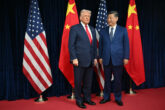March 10, 2011
The Uncertain Rise of China's Military
China’s growing defense budget – in addition to its claim of sovereignty in the South China Sea, anti-satellite weapons testing, and interest in cyber military capabilities – has raised questions about the implications of its rising military power, noted Center for a New American Security (CNAS) Fellow Abraham Denmark in congressional testimony to the U.S.-China Economic and Security Review Commission on March 10, 2011. “The question of how China will use its newfound power, especially its military power, will determine the course of the 21st century,” said Denmark.
“China is adopting diplomatic positions and developing a robust military capability that combined could undermine American power projection capabilities," said Denmark. "This may, at a more fundamental level, undermine the same liberal international order that has to date enabled China’s rise. Yet China’s future path is not determined, and the development of a robust Chinese military capability does not inherently threaten the United States or the liberal international order."
Denmark argued that the key for American strategists and policymakers is to understand the present ambiguity surrounding China's military, and build a strategy that encourages a more responsible and productive future for Chinese power while defending American interests against the potential for Chinese aggression. In his testimony, Denmark recommends that the United States:
- Encourage China’s positive contribution to global public goods and find opportunities for cooperation between the U.S. military and the People's Liberation Army.
- Work with ASEAN regarding the South China Sea to develop a common, clear message to send to Beijing about what is, and what is not, acceptable behavior.
- React strongly and decisively when China’s actions violate American interests, undermine global public goods, or threaten regional stability.
- Continue to adjust its military capabilities to counter China’s anti-access area denial capabilities.
- Build the military capacities of its allies and partners throughout the Asia-Pacific and identify new partners in the region.
Download China's Arrival: A Strategic Framework for a Global Relationship, a CNAS report co-authored by Denmark, here.
More from CNAS
-
Indo-Pacific Security / Energy, Economics & Security
How to Win the Economic War with ChinaTrump's approach to China has run aground, giving Beijing unprecedented advantage in the economic conflict....
By Edward Fishman & Julian Gewirtz
-
America’s Self-Loathing Is a Losing Hand
This article was originally published in The Washington Post.Around 10 years ago, the United States began a historic shift in its grand strategy toward China, abandoning the b...
By David Feith
-
Indo-Pacific Security / Energy, Economics & Security / Technology & National Security
Selling AI Chips Won’t Keep China Hooked on U.S. TechnologyU.S. policy should not rest on the illusion that selling chips can trap China inside the American tech ecosystem....
By Janet Egan
-
Will New Delhi-Beijing Move Beyond Friction Points? | Ex-White Official On India-China Reset
Prime Minister Narendra Modi on Friday said that India and China, as two major economies, must work together to bring stability to the global economic order. NDTV's Gaurie Dwi...
By Lisa Curtis




